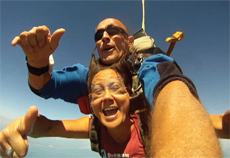




| Home | Features | Club Nights | Underwater Pics | Feedback | Non-Celebrity Diver | Events | 18 April 2024 |
| Blog | Archive | Medical FAQs | Competitions | Travel Offers | The Crew | Contact Us | MDC | LDC |

|

|
 
 |
 ISSUE 21 ARCHIVE - DIVE DENTISTCelehte FortuinMaybe it's just me, but sometimes when a query comes my way, I can't help but wonder if the divers are being treated for the bends or not? Or indeed if I have the bends? Having covered most topics form barodontology, cracked teeth, diver's mouth syndrome, dry mouth syndrome, wet mouth syndrome (stop drinking the sea water!), dental implants, lost crowns, hissing teeth, dentures, braces, custom mouth guards and the odd exploding tooth, I really thought I had heard it all. But alas no! Behold this little gem!Q . During my last dive trip I had the misfortune of a gradually increasing toothache on each subsequent dive. The tooth ache came from a back molar tooth that had root treatment started, but not completed. This tooth was completely fine and pain free by the time the trip came up and, as I had already paid for it, decided to risk it and go diving. BIG MISTAKE. After about the 3rd day of struggling through painful ascents and safety stops, a curious wobbliness to the tooth, increasing sinus and headaches post dives and a swelling on the side of the tooth, I decided to throw in the fins. A few hours post dive and enjoying a beer, I noticed a tightness and what felt like a swelling of my check area (strong beer, I thought!). However, the rest of the group had also started noticing my alarming facial swelling and I was summarily rushed off to the local hospital, given appropriate pain relief, a dental abscess confirmed (x-rays taken as well) and placed on some horse strength antibiotics that got the swelling down within a day or so. The flight back was far from pleasant as the pain and swelling slowly returned but then quickly died down a day or so after landing. My question is why this happened and will it happen again?Ouch, ouch and ouch again. I think it's safe to say that your symptoms and subsequent development of facial swellings, headaches and sinus pain stemmed from the incomplete root canal treated molar. The medication and temporary filling on a root treated tooth is porous by nature and, due to the method of inserting the medication into the thin canals, often trap air within the tooth. The pain on ascent is a sign of this air having been compressed during the dive and then expanding again. This is the main reason we do not recommend diving with incomplete and temporised fillings. The possibility of barotrauma to the teeth in the form of cracking or breaking fillings is too high. A second consideration I have to give, in your situation in particular, is the likelihood of a connection between the root apex (tip of the root) and the maxillary sinus in the check. Because of the close relationship between our molar and premolar (back) teeth and this sinus, any invasive procedure like taking a tooth out and root canal therapy, where perforation of the sinus membrane is possible through the relationship to the root apex, we always have to consider other implications of our treatment and complications that may arise. This may be referred to as an Oro-antral fistula or OAF. Strictly speaking this is a direct opening between the sinus into the mouth cavity, most commonly arising during tooth extraction or bone surgery. However, in your situation where there could be a connection between the sinus and the mouth via the tooth, it could, in a non-conventional way, be considered an OAF. By the sound of your sinus pain and headaches there may well have been a connection between the tooth and the sinus, allowing for the trapped air to move between the tooth and sinus during compression and decompression whilst diving. Post diving, this decompressed air will follow the path of least resistance, hence the swelling on the side of the tooth and the wobbly feeling due to the loss integrity and the bony support being undermined. Due to the way we are so spectacularly put together as human beings, the possibility of air escaping between the many fine layers between the bone, sinus and skin, is what could explain the swelling of your face and check area so shortly after your last dive. Air which will have been dispersed given enough time. This, however, is a very rare complication for regular root canal treatment, but a special consideration to be given to SCUBA divers due the nature of all the body compartments and air spaces subjected to huge amounts of pressure changes during diving. So what happens now? This depends on what your dentist finds during your next dental visit. Upon removal of the temporary filling, the tooth should be carefully inspected under magnification (if possible) to establish if any hairline cracks have become apparent or presented themselves due to the pressure exerted on a fairly “hollow" tooth. After careful review of x-rays and a thorough revision of your symptoms, it could be possible to continue with root canal treatment. I would personally refer you to a specialist for this as the tooth has had quite an assault during your dive trip and for all intents and purposes, this option may not be viable anymore and a tooth removal planned if the prognosis is poor. This case really brings home the point of regular dental visits and x-rays for SCUBA divers especially, to check the integrity of fillings and health of tooth nerves and, more importantly, to have complicated treatment completed before a dive holiday. Safe diving and happy flossing everyone! |